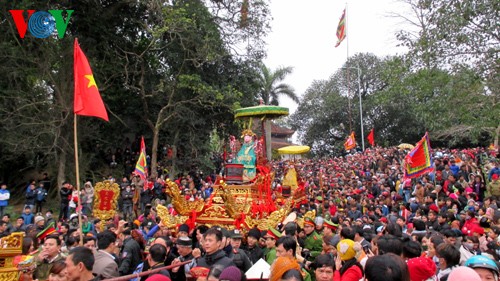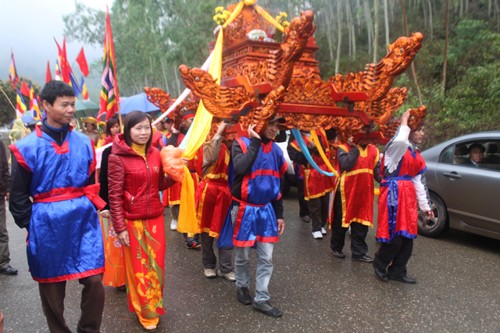(VOVworld) – There are about 8,000 folk festivals in Vietnam, most of them taking place in spring from the first to the fourth lunar month. Almost all the villages hold festivals. Typical festivities include the Hung Kings Temple festivals, Lim festival, Yen Tu festival, and Huong (Perfurme) pagoda festival. Vietnamese folk festivals are associated with villages and regions and an essential cultural factor in a community’s life.
Spring, a season of festivities, has arrived in Vietnam, attracting pilgrims and tourists. Festival goers wish for good luck, favorable weather and success. Researcher Vu Hong Thuat of the Vietnam Museum of Ethnology says the spring festivals share a common point that they reflect the people’s gratitude to the local gods:“A festival’s rites include worshipping, processions, prayers and sacrificial offering to the gods. But the rites may differ between villages or regions. For example, in Tu Xa festival of Phu Tho province on the 11th, 12th and 13th days of the first lunar month, boys and girls poke one another with a secret object. In a festival of Bac Giang province, a plate of soft green-bean cake is a compulsory offering to the gods”.
 |
| The Dong Cuong temple festival |
The central highlands’ festivals are typified by the worshipping of a solar deity, sportsmanship and humanity. Professor Ngo Duc Thinh, a member of the National Heritage Council, reveals his feeling about a funeral oration for a dead buffalo:“When reading the translated version, I was moved to tears, sympathizing with the love a mother for her buffalo. The oration goes: “Today you eat the last grass; I will no longer hear your voice. But do you know that the villagers have run out of rice and you are chosen as a sacrifice for the gods, who will bless villagers with rice. It is you who help bring us a well-fed life”.
 |
| A palanquin procession |
Festivals, small or big, in the delta or mountains, reflect a community’s cohesion. Influenced by the spirit of remembering the source of the water one drinks, these festivals recreate the exploits of their ancestors’. This is a bridge between the past and present so that today’s generation can better understand the nation’s traditions. The majorities of festivals is connected with historical events and honor those who helped to defeat foreign invaders. That’s why sportsmanship is so important in Vietnamese festivals, according to researcher Thuat: “Sportsmanship is widespread across the festivals, villages, temples and pagodas. It can be seen in wrestling competitions and customs. Ethnic people hold archery and horse riding competitions. National unity is dominant. Personal characteristics are also reflected”.
During these festivals, people are able to join lively activities such as elephant and palanquin processions, swimming, and boat races. These activities cherish collective strength and the individual’s role in a community. Similarly, there are competitions between animals such as the fights of birds, cocks, fish, birds, oxen and buffaloes. The most notable buffalo fight in the Do Son district of Hai Phong city.
Festivals not only champion physical strength but also the human soul, wisdom, bravery and nobility of mind. The nation’s historical and cultural values are reflected in the thousands of festivals taking place across Vietnam.